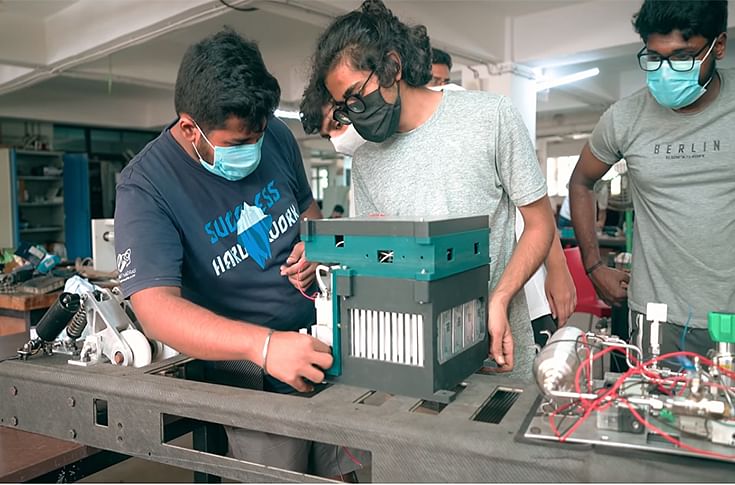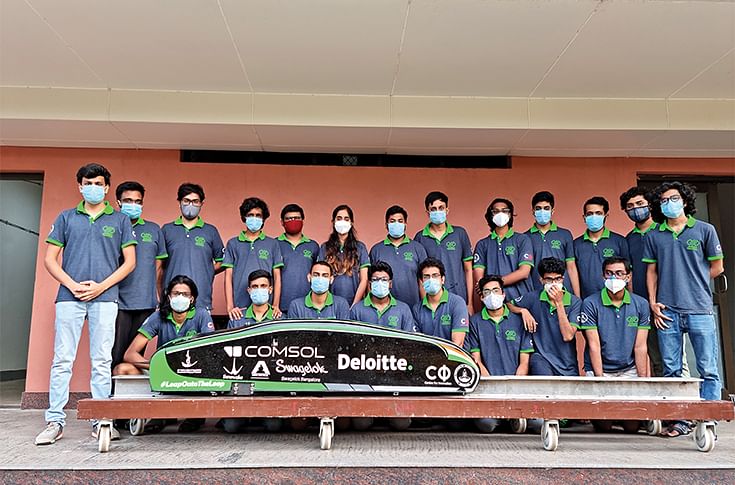Home-grown Hyperloop
A bunch of young motivated engineers at the Centre for Innovation in IIT Madras recently won the ‘Most Scalable Design Award’ at the European Hyperloop Week and was one of the top five teams.
Travelling 300km within minutes? That too in a pod that transports you seamlessly at a speed of 1,000kph? Hyperloop is the answer to these questions and with it the future is already here.
With Hyperloop, vehicles, called pods, accelerate gradually via electric propulsion through a low-pressure tube. The pod floats along the track using magnetic levitation and glides at airline speeds for long distances due to ultra-low aerodynamic drag.
Transportation history was made on November 8, 2020 in the Nevada desert, where US-based transportation technology firm Virgin Hyperloop tested human travel in a Hyperloop pod for the first time.
The system can propel passenger or cargo pods at speeds of over 1,000kph. That is 3x faster than high-speed rail and more than 10x faster than traditional rail. The passengers in the first demonstration were transported over a distance of 500 metres in a mere 15 seconds in the test pod, which was designed to fit only two people. The final product, however, will have a seating capacity of 28 passengers, according to Virgin Hyperloop.
Indian engineering
Now, Hyperloop is being created in India, in Chennai, by a team of students whose average age is twenty-one. A few years ago, a group of young individuals from IIT-Madras came together for the Hyperloop as a project and research.

Over the years, they formed a team called Avishkar. Since then, the team has been working with a single-minded focus on building a pod, a tube that carries the pod and the other technologies that require making this a scalable and viable option.
Earlier this year, Team Avishkar won the ‘Most Scalable Pod Design Award’ at the European Hyperloop Week held in Valencia between July 19-25. It was an event that represents the need for sustainable transportation and collaboration for technological development. The underscores the need for collaboration between teams, companies, in fact the entire world. It provided an opportunity to any student teams, start-ups, foundations and companies to present their research, innovations and developments in the field of Hyperloop — billed as the fifth mode of transportation.

Two years ago, Team Avishar had participated in the SpaceX Hyperloop Pod Competition, and their effort and work was appreciated by none other than Tesla CEO Elon Musk, who first proposed the idea of having the fifth mode of transport — the Hyperloop — to the world in 2013.
Walking the tech talk
It was during the height of the pandemic that the team built its latest pod 'Garv', which is equipped with many novel technologies. The prototype pod was completely built in-house from scratch and won the 'Most Scalable Pod Design Award'. The students, who were finding it difficult to work from home, received special permission from IIT-Madras to work for the competition at the institute.
“The idea of having levitating pods inside vacuum tubes was there for a long time. In 2017, we began our first campaign. We had a team of 20-25 members in the first year. In 2018, we thought of adding suspension, structure and propulsion to the pod. In the final pod, we added BLDC motors for propulsion,” says Bharat Bhavsar, Team Head, Avishkar Hyperloop, a fourth year undergraduate, Department of Aerospace Engineering, in an exclusive interaction with Autocar Professional.

The pod also has a passive suspension mechanism, CFRP chassis in a CFRP shell, an in-house battery pack system, communication mechanism, and friction braking. Team Avishkar did not just stop there with the idea of having a scalable pod design . . . it also looked for an option to develop the vacuum tube infra for the Hyperloop.
“Around 70 percent of the development is in the vacuum tube. We have to figure out how to maintain the vacuum without any leakages, safety and more. Without this we cannot think of implementing it," points out Bhavsar. With scalability in mind, the team is looking to build a 0.5km vacuum tube inside the IIT-M campus soon. "This will be completed by January 2022," he adds.
This is the first stage in a process to make the Hyperloop work as a commercially viable option. It is at the IIT-M campus where they will test the home-grown pod. And, when they get the optimised results, the team will look to scale up the model which will be close to the Hyperloop system. This will happen within 2-3 years after the previous stage. Later, the learnings will be implemented in the Hyperloop corridor. The team has conducted studies for a corridor between Chennai and Bengaluru which will have a travel time of 30 minutes. Another viable option can be the Chennai-Pondicherry corridor.
“These are just in the starting stage. We want the government and the general public to come and appreciate the work we do. The major aspect is to convince them both that this is a viable and a better option. We have been talking to government agencies and critical aspects are being pointed out. Once the tube is in place, we feel that Hyperloop travel is possible at a lesser cost. And, through this R&D, we want India to be the centre of Hyperloop development,” the team head states.
Team Avishkar
With an average age of 20-21, the team has four groups, each with separate heads. The groups include:
-Electrical: Inverter, communication in pods, battery packs.
-Electromagnetic. levitation, propulsion
-Mechanical: Suspension module, aerodynamics, chassis.
-Business group.
Their faculty advisor is Prof. Satyanarayan Chakravarthy, Professor, Department of Aerospace Engineering and Vibhor Jain is the Scalability Head. He is a third year undergraduate, Department of Civil Engineering. Yash Gautam, Business & Outreach Head, Avishkar Hyperloop, (second year Master’s student, Department of Mechanical Engineering) says that to build a vacuum system between two cities is pretty costly. “We wanted to build a commercially viable solution rather than being just a team."
He also points out that they are looking to test the pods with cargo. “We are thinking of building small systems between docks like in Chennai container hubs. Here is where the containers come inland then deboarded and taken to docks. This is just to test the process so that we have a robust system. Scalability and safety is the main
focus this year,” remarks Gautam.
Every year new members join the team, while a few leave after transferring the knowledge. Bhavsar says it needs a lot of dedication to spend time on this project, as it is a big task. Currently, the team has 70 members which comprises a mixed pool of second year and third year graduates too. Many such small projects have been incubated at IIT-M and taken shape as organisations. For example, there's electric two-wheeler manufacturer Ather Energy and battery manufacturer Grinntech. But, can Team Avishkar metamorphosise into an organisation in the near future?
“Having an organisation is a bit of a strange thing to do because things change over the years. This is not a one-person team. But we are thinking about having a consortium model. It will have students, professors, corporate and be brought together under a common platform. It will be a pipeline where the team can contribute,” the team head explains.
Patents and support
The team is in the process of getting provisional patents for the design of the tube and the pod levitation mechanism. “We have other design ideas. But, after we conduct intense research, we can pitch it to the patent property,” says Vibhor Jain.
In making the pod with the technology, the team could get almost all parts from the Indian market except a few. For example, they built an inverter for the pod, which is a complex design and had to import a few components as such designs are not available in India. “Getting components in India is also cost effective. We design in such a way that we could procure from India. But things like batteries, cells and some more have to be imported. So, we have seven sub-systems and an approximate value of 25 percent is what is procured from abroad,” reveals Bhavsar.
Thus far, the team has benefited from solid industry support over the years. In FY2021, Deloitte India was the title sponsor, COMSOL Multiphysics (gold sponsor), Swagelok Bangalore (silver sponsor) and Arus MR Tech and Benewake (supporting sponsors).
“We have been interacting with a lot of people in corporate and government agencies. And, we have received good traction in recent times. So, with the government's help and recognition, Hyperloop can soon be a viable option,” the team head signs off on a very optimistic note.
This feature was first published in Autocar Professional's October 1 issue.
RELATED ARTICLES
Belrise Industries: A Story of Grit and Focus
The Belrise Industries IPO is the culmination of a multi-decade journey by entrepreneur Shrikant Badve that started in a...
Mahindra and Lightweighting: Solid Steel To Nimble Aluminum
Stricter emission regulations and rising fuel efficiency targets are driving a fundamental transformation in powertrain ...
Hero vs Honda: In Numbers
A Comparative Study of Honda Motorcycle & Scooter India and Hero MotoCorp.





 06 Oct 2021
06 Oct 2021
 10097 Views
10097 Views





 Shahkar Abidi
Shahkar Abidi


 Ketan Thakkar
Ketan Thakkar

 Autocar Professional Bureau
Autocar Professional Bureau

